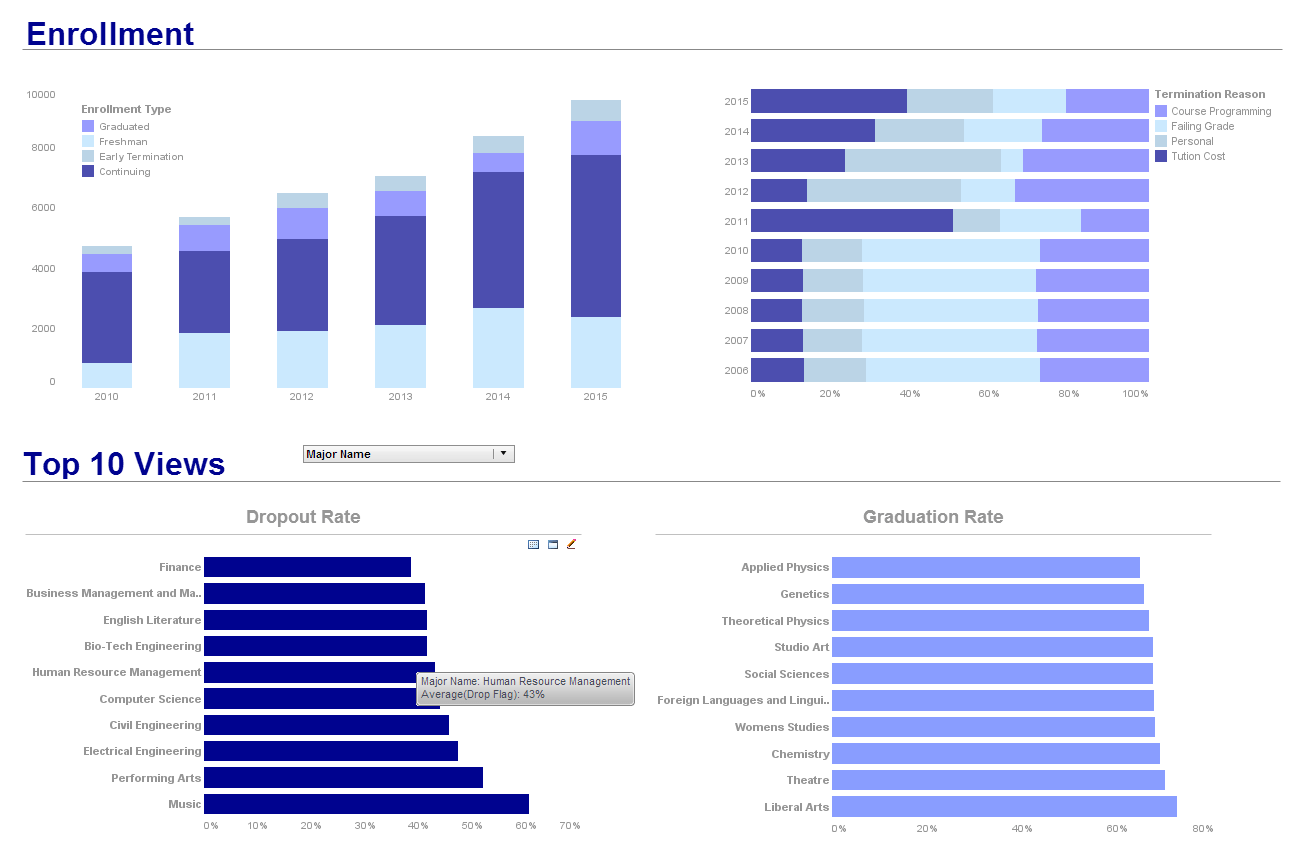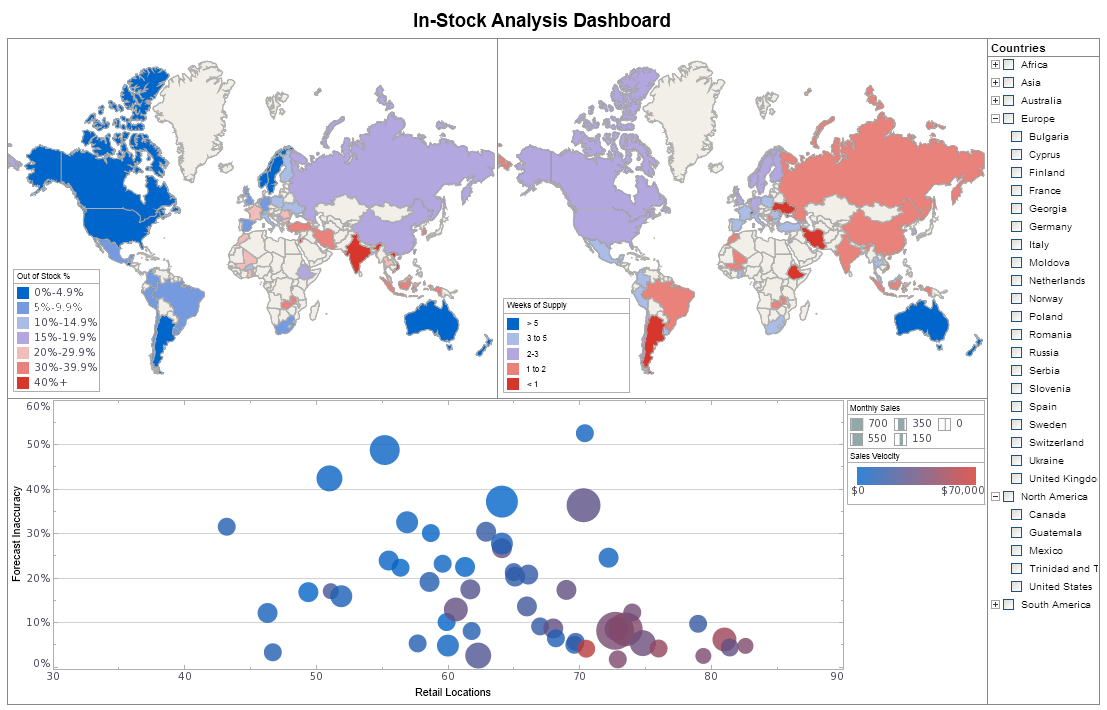Try InetSoft's Server-based BI Tool
Are you looking for the best server-based BI tools? Since 1996 InetSoft has been making BI software that is easy to deploy and easy to use. Build self-service oriented dashboards and visual analyses quickly. InetSoft's data mashup engine solves the data access and transformation challenges that other tools cannot. Learn why we were rated #1 by Butler Analytics and download one of our applications for free.



Why InetSoft?
InetSoft's mobile BI reporting application is easy enough to be:
- Deployed in just weeks
- Learned by end users with minimal training
- Used by any executive without the aid of IT
agile enough to be:
- Adaptable to changing data and business needs
- Used for data exploration through visualization
- Capable of maximum self-service
and robust enough to:
- Attract the attention of executives
- Meet the demands of power users
- Scale up for organizations of any size
Evaluate StyleBI from InetSoft. It's Easy. Agile. & Robust.
Register for more info and to download free eval software
About InetSoft
Since 1996 InetSoft has been delivering easy, agile, and robust business intelligence software that makes it possible for organizations and solution providers of all sizes to deploy or embed full-featured business intelligence solutions. Application highlights include visually-compelling and interactive dashboards that ensure greater end-user adoption plus pixel-perfect report generation, scheduling, and bursting. InetSoft's patent pending Data Block technology enables productive reuse of queries and a unique capability for end-user defined data mashup.
This capability combined with efficient information access enabled by InetSoft's visual analysis technologies allows maximum self-service that benefits the average business user, the IT administrator, and the developer. InetSoft was rated #1 in Butler Analytics Business Analytics Yearbook, and InetSoft's BI solutions have been deployed at over 5,000 organizations worldwide, including 25% of Fortune 500 companies, spanning all types of industries.
 |
Read the top 10 reasons for selecting InetSoft as your BI partner. |
What Data and Metrics Do Earth Observation Services Track?
The following sections outline the key types of data and metrics that EOS typically monitor, as well as their applications and significance.
1. Atmospheric Data
Air Quality Metrics
EOS track various air quality parameters such as concentrations of pollutants including carbon dioxide (CO2), sulfur dioxide (SO2), nitrogen oxides (NOx), particulate matter (PM2.5 and PM10), and ozone (O3). These metrics are crucial for assessing the impact of human activities on air quality and for developing strategies to reduce pollution. Monitoring air quality helps in understanding the sources and distribution of pollutants, enabling policymakers to implement effective air quality management programs.
Weather and Climate Metrics
Weather data, including temperature, humidity, wind speed and direction, and precipitation, are continuously monitored by EOS. Climate metrics, such as long-term temperature trends, seasonal variations, and extreme weather events, are also tracked. These data points are vital for weather forecasting, climate modeling, and studying the impacts of climate change. Accurate weather predictions assist in disaster preparedness, agriculture planning, and infrastructure development, while climate data supports research on global warming and its mitigation.
2. Land and Vegetation Data
Land Use and Land Cover
EOS provide detailed information on land use and land cover changes over time. This includes monitoring deforestation, urban expansion, agricultural activities, and natural vegetation changes. Land use data is essential for sustainable land management, urban planning, and conservation efforts. For instance, tracking deforestation rates helps in developing policies to protect forests and biodiversity.
Vegetation Health and Biomass
Metrics such as the Normalized Difference Vegetation Index (NDVI) and the Enhanced Vegetation Index (EVI) are used to assess vegetation health and biomass. These indices are derived from satellite imagery and indicate the presence and condition of plant life. Monitoring vegetation health is crucial for agriculture, forestry, and ecosystem management. It helps in detecting droughts, assessing crop yields, and managing natural resources sustainably.
3. Water Resources Data
Surface and Groundwater
EOS track the quantity and quality of surface and groundwater resources. This includes monitoring river flows, lake levels, and groundwater aquifers. Data on water resources is essential for managing water supply, ensuring water quality, and preventing water-related conflicts. For example, tracking groundwater levels can help in identifying over-extraction and promoting sustainable water use practices.
Ocean and Coastal Metrics
Oceanographic data such as sea surface temperature, salinity, ocean currents, and wave heights are monitored by EOS. Coastal metrics include shoreline changes, sea level rise, and coastal erosion. These data points are critical for understanding marine ecosystems, predicting and managing the impacts of sea level rise, and supporting marine navigation and fisheries management. Coastal data also play a significant role in protecting coastal communities from storm surges and tsunamis.
4. Biodiversity and Ecosystem Data
Species Distribution and Habitat Mapping
EOS track the distribution of various species and their habitats. This includes mapping critical habitats for endangered species and monitoring changes in biodiversity. These metrics are vital for conservation planning, habitat restoration, and biodiversity protection. By understanding species distribution, conservationists can develop strategies to protect critical habitats and maintain ecological balance.
Ecosystem Services
Metrics related to ecosystem services, such as carbon sequestration, water filtration, and pollination, are also monitored. These services are essential for human well-being and environmental sustainability. For example, tracking carbon sequestration rates helps in assessing the role of forests and other ecosystems in mitigating climate change by absorbing CO2 from the atmosphere.
5. Human Activity and Infrastructure Data
Urbanization and Infrastructure Development
EOS provide data on urban growth, infrastructure development, and land use changes in urban areas. This includes monitoring the expansion of cities, the development of transportation networks, and the construction of new buildings. Urbanization metrics are crucial for sustainable urban planning, transportation management, and infrastructure development. They help in designing cities that are resilient, efficient, and environmentally friendly.
Agricultural Practices
EOS track agricultural activities, including crop types, planting and harvesting dates, irrigation practices, and soil health. These data points are essential for improving agricultural productivity, ensuring food security, and managing natural resources sustainably. For instance, monitoring crop health and soil moisture levels can help farmers optimize irrigation and fertilization practices, leading to increased yields and reduced environmental impact.
6. Disaster and Risk Management Data
Natural Disasters
EOS track and monitor natural disasters such as earthquakes, hurricanes, floods, wildfires, and volcanic eruptions. Metrics related to the frequency, intensity, and impact of these events are crucial for disaster preparedness, response, and recovery. For example, real-time monitoring of hurricanes helps in predicting their path and intensity, enabling timely evacuation and preparation measures to minimize damage and loss of life.
Vulnerability and Risk Assessment
Data on population density, infrastructure vulnerability, and hazard exposure are used to assess the risk and vulnerability of different regions to natural disasters. These metrics are essential for developing risk mitigation strategies, enhancing resilience, and planning for emergency response. By identifying high-risk areas, authorities can allocate resources more effectively and implement measures to protect vulnerable populations.
7. Environmental and Socioeconomic Indicators
Sustainable Development Goals (SDGs)
EOS track various indicators related to the United Nations Sustainable Development Goals (SDGs). This includes metrics on poverty, health, education, gender equality, clean water, and sustainable cities. These indicators are essential for monitoring progress towards achieving the SDGs and for informing policy decisions. For example, data on access to clean water and sanitation helps in designing interventions to improve public health and reduce inequalities.
Environmental Impact Assessment
Metrics related to environmental impact, such as greenhouse gas emissions, pollution levels, and resource consumption, are also monitored. These data points are crucial for assessing the environmental footprint of human activities and for developing strategies to reduce environmental impact. By understanding the environmental consequences of different actions, policymakers and businesses can implement measures to promote sustainability and protect the environment.
 |
View the gallery of examples of dashboards and visualizations. |
More Articles About Server-based BI
Centers of Excellence Become More Prevalent - So, it is becoming very prevalent not just in North America and not just in India, I am seeing it happen in Europe. I am seeing it happen in Japan and Australia. All over the world we’re starting to see COEs, and I think this has been the year that it really has come to life. And so let’s put up another poll, ‘does your organization have a business analysis center of excellence, community of practice or some sort of “centralized” resource that Business Analysts can use to help them with day to day activity...
Impact of Integrating ERP and BI - The impact of integrating ERP and BI can be felt in many ways. Companies that have integrated BI and ERP together are seeing a 67% decrease in administrative costs and improvement in on-time shipment, so lots of the tactical areas of the business are improving. Best in class performers are those that perform in the top 20% of all survey respondents that we measure are seeing an improved ease of use as the functional users can perform self-service data analysis. So in the days when BI and ERP were separate there was a report request made and IT had to get involved and then you were told it will take two hours or two days or two weeks and then it came back...
Key Measures for Government Projects - Do not overload your dashboards. Your aim is to highlight the priority areas and demonstrate how the tracking of data or the key projects are helping with improving the city's performance. That's it. Information overload is not necessary. When it comes to reviewing your performance, your community needs an easy and simple way. They will not prefer turning over a multiple pages' report. So, offer them crisp information that is of the highest priority. You must display each measure and project...
Medical Device Manufacturing BI - A medical device manufacturer faced multifaceted challenges, including suboptimal production planning, quality control issues, lack of supply chain visibility, and limited understanding of market trends. These challenges were impeding their ability to meet demand effectively and innovate in line with customer preferences...

